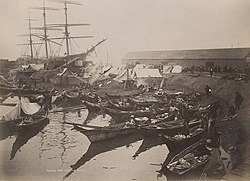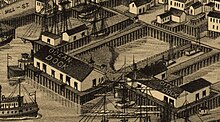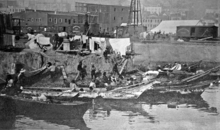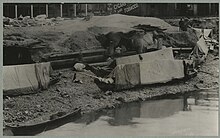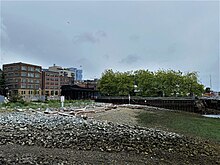
Chief Seattle was a 19th-century leader of the Duwamish and Suquamish peoples. A leading figure among his people, he pursued a path of accommodation to white settlers, forming a personal relationship with "Doc" Maynard. The city of Seattle, in the U.S. state of Washington, was named after him. A widely publicized speech arguing in favor of ecological responsibility and respect of Native Americans' land rights had been attributed to him.

The Duwamish River is the name of the lower 12 miles (19 km) of Washington state's Green River. Its industrialized estuary is known as the Duwamish Waterway. In 2009, the Duwamish Longhouse and Cultural Center was opened on the west bank of the river as part of the tribe's reassertion of its historic rights in the area and its continuing struggle for federal recognition of tribal status.

Elliott Bay is a part of the Central Basin region of Puget Sound. It is in the U.S. state of Washington, extending southeastward between West Point in the north and Alki Point in the south. Seattle was founded on this body of water in the 1850s and has since grown to encompass it completely. The waterway it provides to the Pacific Ocean has served as a key element of the city's economy, enabling the Port of Seattle to become one of the busiest ports in the United States.

The Duwamish are a Lushootseed-speaking Southern Coast Salish people in western Washington, and the Indigenous people of metropolitan Seattle.
Two conflicting perspectives exist for the early history of Seattle. There is the "establishment" view, which favors the centrality of the Denny Party, and Henry Yesler. A second, less didactic view, advanced particularly by historian Bill Speidel and others such as Murray Morgan, sees David Swinson "Doc" Maynard as a key figure, perhaps the key figure. In the late nineteenth century, when Seattle had become a thriving town, several members of the Denny Party still survived; they and many of their descendants were in local positions of power and influence. Maynard was about ten years older and died relatively young, so he was not around to make his own case. The Denny Party were generally conservative Methodists, teetotalers, Whigs and Republicans, while Maynard was a drinker and a Democrat. He felt that well-run prostitution could be a healthy part of a city's economy. He was also on friendly terms with the region's Native Americans, while many of the Denny Party were not. Thus Maynard was not on the best of terms with what became the Seattle Establishment, especially after the Puget Sound War. He was nearly written out of the city's history until Morgan's 1951 book Skid Road and Speidel's research in the 1960s and 1970s.

Alki Point is a point jutting into Puget Sound, the westernmost landform in the West Seattle district of Seattle, Washington. Alki is the peninsular neighborhood on Alki Point. Alki was the original settlement in what was to become the city of Seattle. It was part of the city of West Seattle from 1902 until that city's annexation by Seattle in 1907.
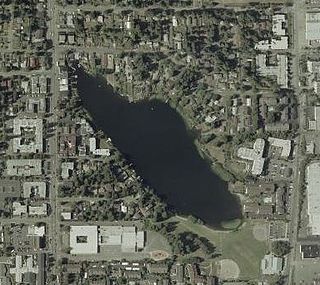
Bitter Lake is a small lake in northwest Seattle, Washington, USA.

Union Bay is a body of water located in Seattle, Washington. Part of Lake Washington, it is bounded by the Laurelhurst neighborhood to the north and the Montlake and Madison Park neighborhoods to the south. The Evergreen Point Floating Bridge, which carries State Route 520, crosses over a portion of the bay.

Salmon Bay is a portion of the Lake Washington Ship Canal, which passes through the city of Seattle, linking Lake Washington to Puget Sound, lying west of the Fremont Cut. It is the westernmost section of the canal and empties into Puget Sound's Shilshole Bay. Because of the Hiram M. Chittenden Locks, the smaller, western half of the bay is salt water, and the eastern half is fresh water.

Leschi Park is an 18.5 acres (75,000 m2) park in the Leschi neighborhood of Seattle, Washington, named after Chief Leschi of the Nisqually tribe. The majority of the park is a grassy hillside that lies west of Lakeside Avenue S. and features tennis courts, picnic tables, and a playground. Across Lakeside Avenue to the east is the western shore of Lake Washington and a small lawn with benches. To its south is the southern portion of Leschi Moorage, separated from the northern portion by a parking lot in the E. Yesler Way right-of-way, private docks, and an office/restaurant complex.

The city of Seattle, Washington, is located on a narrow isthmus between Puget Sound on the west and Lake Washington on the east; water comprises approximately 41% of the total area of the city. It was founded on the harbor of Elliott Bay, home to the Port of Seattle—in 2002, the 9th busiest port in the United States by TEUs of container traffic and the 46th busiest in the world.

Princess Angeline, also known in Lushootseed as Kikisoblu, Kick-is-om-lo, or Wewick, was the eldest daughter of Chief Seattle.

Duwamish Head is the northernmost point in West Seattle, Washington, jutting into Elliott Bay.
The region now known as Seattle has been inhabited since the end of the last glacial period. Archaeological excavations at West Point in Discovery Park, Magnolia confirm that the Seattle area has been inhabited by humans for at least 4,000 years and probably much longer. West Point was called Oka-dz-elt-cu, Per-co-dus-chule, or Pka-dzEltcu. The village of tohl-AHL-too had been inhabited at least since the 6th century CE, as had hah-AH-poos—"where there are horse clams"—at the then-mouth of the Duwamish River in what is now the Industrial District. The Lushootseed (Skagit-Nisqually)-speaking Salish Dkhw'Duw'Absh and Xacuabš —ancestors of today's Duwamish Tribe—occupied at least 17 villages in the mid-1850s and lived in some 93 permanent longhouses (khwaac'ál'al) along the lower Duwamish River, Elliott Bay, Salmon Bay, Portage Bay, Lake Washington, Lake Sammamish, and the Duwamish River tributaries, the Black and Cedar Rivers.
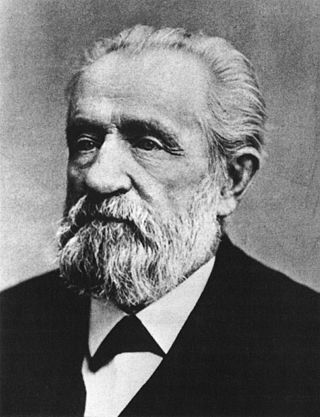
Henry Leiter Yesler was an American entrepreneur and a politician, regarded as a founder of the city of Seattle. Yesler served two non-consecutive terms as Mayor of Seattle, and was the city's wealthiest resident during his lifetime.

The Battle of Seattle was a January 26, 1856 attack by Native American tribesmen upon Seattle, Washington. At the time, Seattle was a settlement in the Washington Territory that had recently named itself after Chief Seattle (Sealth), a leader of the Suquamish and Duwamish peoples of central Puget Sound.
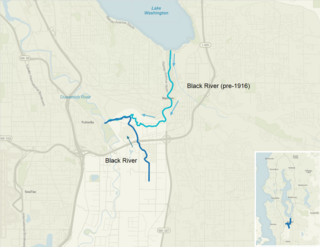
The Black River is a tributary of the Duwamish River in King County in the U.S. state of Washington. It drained Lake Washington until 1916, when the opening of the Lake Washington Ship Canal lowered the lake, causing part of the Black River to dry up. It still exists as a dammed stream about 2 miles (3.2 km) long.

The Central Waterfront of Seattle, Washington, United States, is the most urbanized portion of the Elliott Bay shore. It runs from the Pioneer Square shore roughly northwest past Downtown Seattle and Belltown, ending at the Broad Street site of the Olympic Sculpture Park.
Shortly after the settlement's first incorporation in 1865, the Board of Trustees of the Town of Seattle, Washington Territory, passed Ordinance No. 5, subtitled An Ordinance for the Removal of Indians, expelling all Native Americans from residence in the town unless employed and housed by a white settler. Instituted on February 7, 1865, the ordinance banned all Native Americans from living within the town limits of Seattle unless employed by a settler and housed immediately adjacent to their employer.
